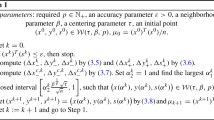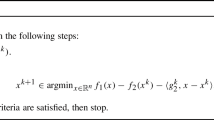Abstract
We observe a curious property of dual versus primal-dual path-following interior-point methods when applied to unbounded linear or conic programming problems in dual form. While primal-dual methods can be viewed as implicitly following a central path to detect primal infeasibility and dual unboundedness, dual methods can sometimes implicitly move away from the analytic center of the set of infeasibility/unboundedness detectors.
Similar content being viewed by others
References
Adler I., Resende M.G.C., Veiga G. and Karmarkar N.K. (1989). An implementation of Karmarkar’s algorithm for linear programming. Math. Program. 44(3): 297–335
Benson S.J., Ye Y. and Zhang X. (2000). Solving large-scale sparse semidefinite programs for combinatorial optimization. SIAM J. Optim. 10(2): 443–461
Gay D.M. (1985). Electronic mail distribution of linear programming test problems. Math. Program. Soc. Comm. Algorithm. Newslett. 13: 10–12
Gonzaga C.C. (1992). Path following methods for linear programming. SIAM Rev. 34(2): 167–224
Gonzaga C.C. and Todd M.J. (1992). SIAM J. Optim. 2: 349–359
Güler O. (1996). Barrier functions in interior point methods. Math. Oper. Res. 21: 860–885
Nesterov Y.E. and Nemirovskii A.S. (1993). Interior Point Polynomial Methods in Convex Programming: Theory and Algorithms. SIAM, Philadelphia
Renegar J. (1988). A polynomial-time algorithm based on Newton’s method for linear programming. Math. Program. 40: 59–93
Roos C., Terlaky T. and Vial J.P. (1997). Theory and Algorithms for Linear Optimization: An Interior Point Approach. Wiley, Chichester
Todd M.J. (2004). Detecting infeasibility in infeasible-interior-point methods for optimization. In: Cucker, F., DeVore, R., Olver, P. and Süli, E. (eds) Foundations of Computational Mathematics, Minneapolis 2002, pp 157–192. Cambridge University Press, Cambridge
Tütüncü R.H., Toh K.C. and Todd M.J. (2003). Solving semidefinite-quadratic-linear programs using SDPT3. Math. Program. 95(2): 189–217
Wright S. (1996). Primal-Dual Interior Point Methods. SIAM, Philadelphia
Ye Y. (1997). Interior Point Algorithms: Theory and Analysis. Wiley, New York
Author information
Authors and Affiliations
Corresponding author
Additional information
Dedicated to Clovis Gonzaga on the occassion of his 60th birthday.
Rights and permissions
About this article
Cite this article
Todd, M.J. Dual versus primal-dual interior-point methods for linear and conic programming. Math. Program. 111, 301–313 (2008). https://doi.org/10.1007/s10107-006-0067-3
Received:
Accepted:
Published:
Issue Date:
DOI: https://doi.org/10.1007/s10107-006-0067-3




